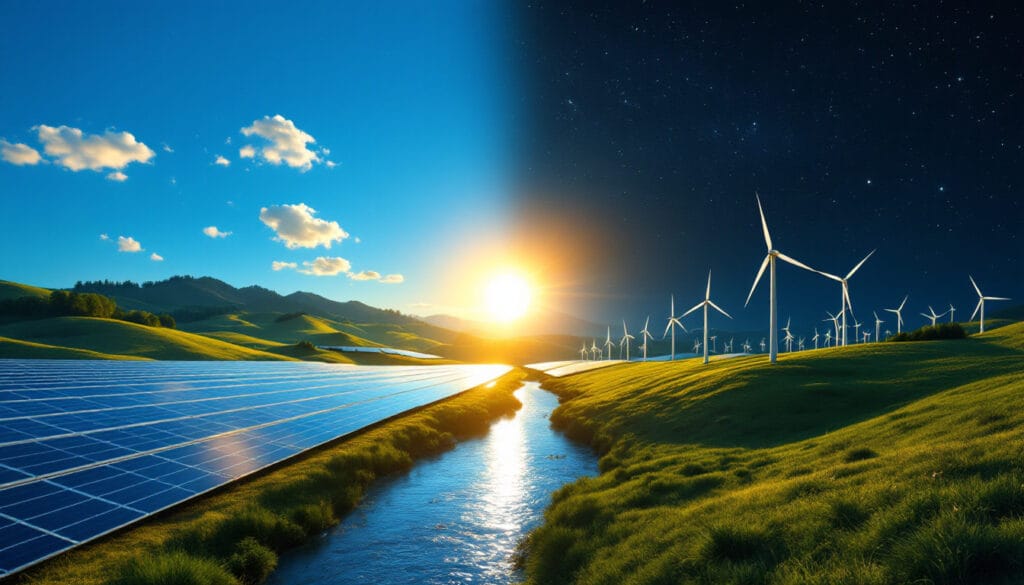If solar and wind energy are familiar to you, marine renewable energies (MRE) represent an exciting new frontier. Harnessing the untapped power of our oceans, these technologies cover innovative solutions such as tidal energy, current turbines, and wave energy. In Brittany, with its vast coastlines and impressive tides, the potential for these marine resources is exceptional. Innovative projects are already testing these promising solutions, paving the way towards a more sustainable energy future that respects marine ecosystems.
Glossary of Marine Renewable Energies (MRE)
Marine Renewable Energies (MRE) constitute a set of innovative technologies that use various resources from the marine environment to generate electricity. This promising sector offers solutions that are respectful of marine ecosystems and represents a viable alternative to conventional energy sources.
Offshore wind energy: Unlike onshore installations, offshore wind turbines benefit from more regular and powerful winds, allowing for increased energy production. This technology is used to capture wind energy through large-scale offshore installations.
Current turbines: Utilizing the energy of marine currents, current turbines resemble submerged wind turbines. They harness the force of water to generate electricity. These systems prove particularly effective in areas of strong currents.
Tidal energy: This technology derives its energy from tides, a natural phenomenon of rising and falling waters. Predominantly found in regions such as Brittany, tidal energy offers impressive reliability due to its predictable nature.
Wave energy: By harnessing the forces of waves, this method uses the movement of waves to generate electricity. Inna Braverman, for example, is noted for her contributions to optimizing this technology. Read more about her work here: Inna Braverman.
Ocean thermal energy: By exploiting temperature differences between surface water and deeper waters, this technique, also known as OTEC, generates energy. It is particularly effective in tropical areas where temperature gradients are significant.
Osmotic energy: Harnessing the differences in salinity between seawater and freshwater, osmotic energy represents a new frontier to explore in the field of MRE. For an in-depth understanding of this method, visit osmotic energy.
With nearly 4,900 kilometers of coastline, Brittany proves to be an exceptional testing ground for these technologies. MRE offers unprecedented innovation prospects to support the electrification of uses while respecting marine ecosystems. Discover the opportunity these untapped resources represent through innovative projects like Tidal Lagoon Power Ltd.
Inspirational Initiatives: Among the influential figures in this field is Tri Mumpuni, who energizes the renewable energy sector in Indonesia. She effectively promotes micro-hydropower systems and the responsible use of natural resources. More information about her inspiring journey is available here: Tri Mumpuni.
Finally, let’s not forget the immense potential of marine energy, which is a fascinating renewable resource to explore. To learn more, check out marine energy, a potential to discover.

Frequently Asked Questions about Marine Renewable Energies (MRE)
Q: What are the different forms of marine renewable energies (MRE)?
A: Marine renewable energies include a range of technologies that harness marine resources to produce electricity. This includes tidal energy (tidal energy), current energy (current turbines), wave energy (waves), and ocean thermal energy.
Q: Why are marine renewable energies important?
A: MRE are valuable allies for electrification and the transition to a more sustainable energy system. They offer ecological alternatives by harnessing the natural power of the oceans while respecting marine ecosystems.
Q: What is the maturity of the different branches of marine renewable energies?
A: The branches of MRE display various levels of maturity. For example, offshore wind turbines are already widely deployed, while other technologies like wave and current energy are still in experimental and development phases.
Q: What geographical advantages favor the development of MRE in Brittany?
A: Brittany, with its 4,900 km of coastline, powerful currents, regular winds, and the largest tides in Europe, has exceptional potential to test and harness different sources of marine energy.
Q: What is the contribution of marine renewable energies to innovation?
A: MRE offer promising prospects for innovation, particularly through diversification of energy sources, decentralization of production, and harmonious integration of technologies into marine ecosystems.
Articles similaires
Thank you!
We will contact you soon.













